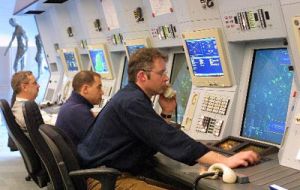MercoPress. South Atlantic News Agency
Air travel scary in South America
 “controllers have to be more sufficiently trained” said Baumgartner, President of Controllers' Associations
“controllers have to be more sufficiently trained” said Baumgartner, President of Controllers' Associations Flying through South America's busiest airports has become frightening and time-consuming for passengers and pilots alike as a surge in travelers overwhelms under funded air traffic control systems.
The Argentine capital's main airport radar hasn't worked properly since being struck by lightning in March, meaning jets must fly under manual control, causing delays and at least two near-collisions, according to air traffic controllers. A September crash that was Brazil's deadliest air disaster exposed other gaps, from inadequate equipment to poor training. Angry stranded travelers have stormed airline check-in counters and runways and fistfights have broken out in waiting areas. Controllers â€" concerned about being made scapegoats â€" have engaged in strikes and work slowdowns to raise safety concerns. The problems in Buenos Aires and Sao Paulo ripple through Latin America and beyond as travelers make connecting flights. On Friday, all flights from Sao Paulo to Europe and the United States were temporarily suspended due to equipment failure and another slowdown by controllers. Brazil and Argentina acknowledge failing to make needed investments in radar for decades, even as South America's booming economies fueled growth in air travel. Foreign travelers to Buenos Aires' main international airport have more than doubled in five years to 2.1 million in 2006, while the number of domestic flights in Brazil has risen by 49 percent, the governments say. The world's pilots have lobbied to solve the problems since a Boeing 737 wound up on a collision course with a small executive jet over the Amazon on Sept. 29, killing all 154 people on the passenger jet. A Brazilian judge indicted four flight controllers and the smaller jet's two American pilots on the equivalent of manslaughter charges, but the defendants point to other problems, from holes in radar coverage to the inability of some Brazilian controllers to clearly speak English, the language of international aviation. Passengers are getting jittery, too. Meghan Bolden, a 26-year-old American studying in Buenos Aires, sweated through takeoff on her United Airlines flight home to Washington. "The pilot, who was American, got on and said we were going to be taking off manually because there was no radar. But it was pitch black and we couldn't see anything on the tarmac," Bolden said. "It's like we were back in the Wright brothers era." Manual takeoffs, spaced several minutes apart, are widely accepted under commercial aviation rules, and Argentine Defense Minister Nilda Garre has insisted her country's system is safe. "There is no such thing as air insecurity" in Argentina, she told an Argentine Senate committee on May 22. She denied a claim by air controllers of at least two near-collisions due to faulty radar. According to transcripts, a U.S. business jet and an Aerosur flight came close enough for the Aerosur pilot to see the other captain's uniform. Another recording indicates that one jet circling over Buenos Aires crossed just 300 yards over another. But Garre acknowledged that the Argentine government has long deferred costly investments in new radars. Bill Voss, president of the independent Flight Safety Foundation in Alexandria, Va., said Argentine authorities were not "exactly forthcoming" with the public about the lightning damage. "Under any circumstances, having a radar down for three months indicates some significant problems in terms of funding and logistics," Voss said. "It should not be that hard to get radar service restored at a major airport." The International Federation of Air Line Pilots' Associations, representing more than 100,000 pilots worldwide, issued a June 1 bulletin saying it was "surprised to learn that three months after it was damaged by a lightning strike, the radar station covering Buenos Aires still has not been repaired." And Marc Baumgartner, president of International Federation of Air Traffic Controllers' Associations, wondered if Argentine controllers have enough training in manual controls. "The problem is with air traffic controllers who are used to working with a radar environment, who are then asked to work in a blind air traffic control environment," Baumgartner said. "These controllers have to be more sufficiently trained." (AP)




Top Comments
Disclaimer & comment rulesCommenting for this story is now closed.
If you have a Facebook account, become a fan and comment on our Facebook Page!